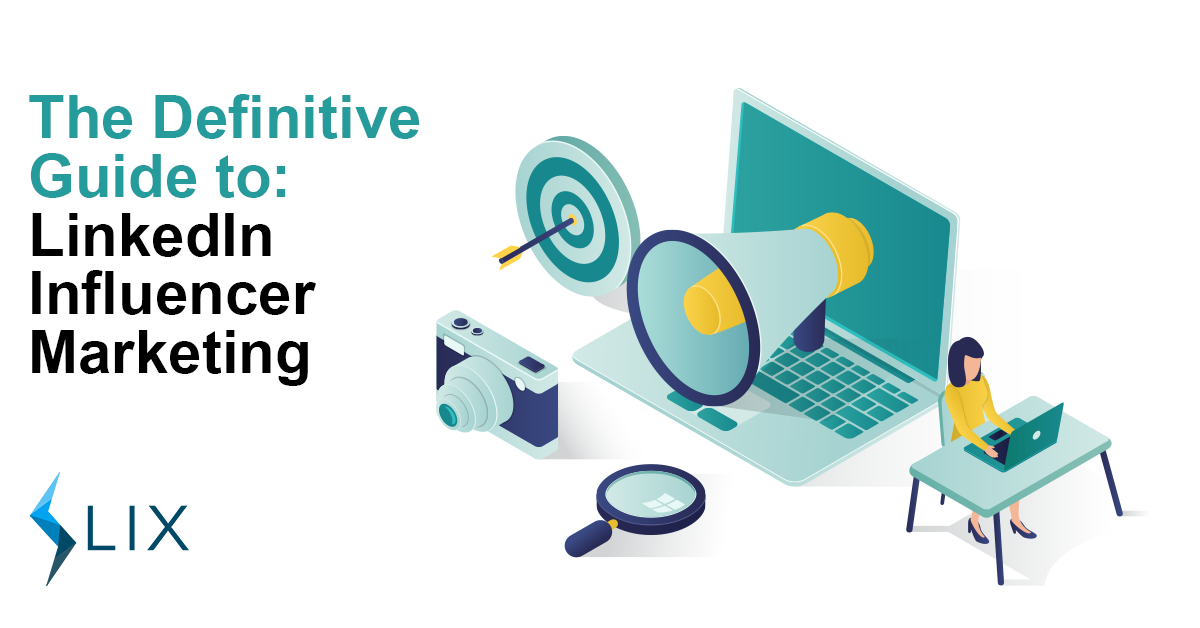LinkedIn influencer marketing is being under-utilised by B2B marketers. We’re on a mission to change that.
In recent years, influencer marketing has grown into an essential part of every B2C marketer’s toolkit. The ability to leverage a trusting audience, pre-built by an influencer, lures in marketers like a moth to a flame. For many of us though, the phrase ‘influencer marketing’ conjures images of perma-tanned reality TV stars peddling protein shakes on Instagram. While this may be true, I certainly wouldn’t advise asking the cast of Love Island to promote your B2B product or service. So, how can us B2B marketers get in on the influencer action? With LinkedIn influencer marketing.
Why LinkedIn Influencer Marketing?
LinkedIn is the largest professional social network in the world, with a whopping 690 million users and counting. The platform has been on a steady growth trajectory since their acquisition by Microsoft in 2016, for a cool $26.2 billion. Microsoft’s investment into the business has reaped dividends, with LinkedIn’s membership growing 52% in just four years.
In early in 2020, as I’m sure you know, the world went into lockdown. The coronavirus pandemic led to an unprecedented wave of people working from home. In fact, you might be reading this from the comfort of your home office right now, for this very reason. The rise in home working set off an explosion in LinkedIn’s engagement rates. In fact, LinkedIn saw its largest jump in DAU (daily active users) since 2011.
Amongst those users, from the casual to the committed, there are the individuals that we marketers dream of getting in front of: the decision makers. According to LinkedIn’s own stats, 61 million LinkedIn users are senior-level influencers and 40 million are in decision making positions.
Let’s take a moment to step back and consider this. We have at our fingertips, the largest business network in history. LinkedIn is an audience of nearly 700 million people and among them, tens of millions of decision makers. This is an unprecedented opportunity for B2B marketers. One that we have of course been leveraging for some time. I would argue however, that we have not been utilising LinkedIn marketing to its full extent. As marketers we run ads, content campaigns, perhaps even cold outreach; all the while LinkedIn influencer marketing remains largely untapped…

As marketers we seek two things: an audience to speak to, and buy-in from that audience. Influencers can give us both of those things at the drop of a hat. They have spent years cultivating a persona, engaging with their followers and establishing themselves as a source of information and inspiration. Yes, even the reality TV stars on Instagram and the dancing teens on Tik-Tok.
The Lure of Influencers
In bygone years marketers and advertisers had to create and manage long-running campaigns to build brand recognition with their audience. Hoping that their efforts along the way cultivated some kind of relationship between brand and consumer. Social media has done away with that in a relative heartbeat. We don’t need to shoehorn emotion, connection and trust into 60 second ads, spaced out and repeated over years. Audiences can feel like they know, and therefore trust, influencers within a matter of weeks. Through photographs, captions, story posts, live videos, podcasts, Q&A sessions… The opportunities to build those connections are seemingly endless.
There is of course another important layer to the influencer marketing cake: it is social. Although there is a huge clue in the name ‘social media’, us marketers can often forget this fact when trying to sell via social platforms. We may be there to sell, but users are not there to buy. They are scrolling through their feed, interacting with their friends and consuming media related to their interests. It’s not SEM, where there is clear intent to buy, or researching buying, a product. You are interrupting their flow with your ad or message. Do you think the user would rather have their flow interrupted by an advert from a business they don’t recognise… or a recommendation from a person they know and trust?
With this in mind, it’s easy to see the power of influencer marketing, and therefore LinkedIn influencer marketing. You are leveraging not only their audience, but trust and social connection. Something that would otherwise take you many years (and thousands of dollars) to build for yourself.
This powerful combination presents us with a massive opportunity. We have a thriving social-professional network, with millions of decision-making users and, if you know where to look, a plethora of influencers ready to promote your products.
LinkedIn Influencers
LinkedIn influencers have established themselves as thought-leaders in their field. Their written content, videos, perhaps even just witty status updates have earned them thousands of fans. Their posts reach the coveted top spots within the LinkedIn feeds of not only their followers, but also those connected to their followers.
LinkedIn influencer marketing is also largely untapped market. How often do you see B2B influencers pushing products on LinkedIn? It happens, but it’s not nearly as large a phenomenon as it is on Instagram and Tik-Tok. If those platforms are anything to go by, we are just a few years away from saturation. As with any new marketing trend, the time to get involved is now.
The early adopters will reap the most rewards. Much like the early days of Facebook pages, and the ease of follow/unfollow at the dawn of Instagram; this trend will become saturated and ROI will gradually decrease. We may reach a point where, much like Facebook, the only way to really reach an audience is pay-to-play. You don’t want to look back in three years and kick yourself for missing the boat.

Influencer Campaign Preparation
Before we delve into the specifics of tracking down influencers, we need to prepare our campaign. As a marketer or solopreneur you will already understand the importance of good prep and solid tracking.
Media, Location, Duration
Setting up a LinkedIn influencer marketing campaign is not much different to any other marketing campaign. There are a few extra things to consider, including the media used, the location of the post, duration and so on.
There are a number of factors that will contribute to your choice of media, including your chosen influencer’s preference.
Where possible, I advise opting for video.
A massive 84% of buyers say they were persuaded to purchase after watching a brand’s video. Since launching native video (uploaded directly to LinkedIn) back in 2017 engagement rates have rocketed.
Within LinkedIn there are three locations you could opt to post your content, whatever it may be:
- The Influencer’s Feed
- Within a Group
- On your Company Page
Of the three, I would generally advise the first option, so that you can really leverage the trust and audience your influencer has built up. Groups can command excellent engagement but promoted posts are generally blocked by group admin. Some marketers advise posting on your company page to build better brand recognition, but unless you have a huge following there, I wouldn’t bother.
Tracking
There is no use throwing time and money at a LinkedIn influencer marketing campaign if you cannot track what works and what doesn’t. Depending on what your desired outcome is from this campaign (clicks, email signups, conversions) there are numerous ways to track. You may wish to send users to a designated landing page, with messaging that matches the content pushed out by your influencer for a seamless customer journey. This is time consuming and perhaps not the best option for your initial test. An easy way of tracking is simply adding UTM parameters to whatever links the influencer may share – this should make it easier to separate out the clicks, visits and conversions from a specific source. You can use Google’s UTM builder for free.

With your campaign idea in mind and your method for tracking results prepped – it’s time to find those influencers!
How to Find LinkedIn Influencers
If you’re familiar with LinkedIn you will probably know that they curate their own list of influencers by invitation only. There are a few hundred of these ordained influencers, including the likes of Melinda Gates, Mike Bloomberg and the ubiquitous ‘Gary Vee’. If you have the kind of budget required to hook one of these big fish, go ahead. For those high-profile targets approaching them via LinkedIn, or even by email, is probably not going to yield results. I would be incredibly surprised if Mike Bloomberg is checking and responding to his DMs on LinkedIn. Your best bet for an upper-echelon influencer like that is to approach their publicist or agent and go from there.
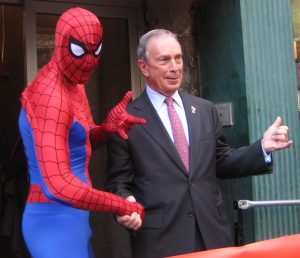
“Now if you’ll excuse me Spiderman, I must go check my LinkedIn messages…”
My guess is that if you’re reading this, you’re either marketing for an SME or you’re a plucky entrepreneur at a startup looking to make your mark. In which case, your pockets likely aren’t deep enough to pay Gary Vee to speak 7000 words a minute about you in a LinkedIn influencer marketing video. Never fear. There are thousands of influencers, thought leaders and LinkedIn populists out there ready to spread your message for a fraction of the cost.
Let’s dive into how we can unearth them before moving onto how to approach.
Get Targeted
Before we can begin our search, we need to think about our selection criteria. My suggestion here is to start with the end result and work backwards.
For example if I wanted to sell LIX subscriptions, I would start by identifying a vertical. I know that LIX offers the ability to export LinkedIn Company Data, and I know that there are four primary verticals that tend to buy this tool: B2B marketers, salespeople, investors and recruiters. This time around, I’d like to target marketers.
Now we have our niche, let’s think about numbers. Begin by thinking about how many individuals you will need to reach with this campaign in order to convert your desired number. I estimate that I can convert approximately 3% of all readers / viewers (depending on the media) and I’m looking for 50 signups to test the viability of LinkedIn influencer marketing. Therefore, I need an influencer in the marketing niche, preferably with interests and content relevant to automation services, with at least 1,500 followers.
With this kind of laser-targeting, we know exactly what we want and what kind of person can deliver on the above. Now, we search…
Find Influencers on LinkedIn
Part of what makes LinkedIn such an incredible tool is its powerful search function. With the right keywords, filters, time and perhaps a helping hand from the LIX LinkedIn Search Exporter you can find relevant profiles, export their data from LinkedIn into a spreadsheet and begin panning for influencer gold!
Continuing our example project, we’re searching digital marketing automation specialists. If we enter that into the LinkedIn search bar and select the ‘people’ filter around 669k results are returned.

I would advise applying some filters in order to not only bring down that number, but also hone-in on your desired influencer. For this campaign, I want to reach influencers based in the UK, so I will filter by location ‘United Kingdom’ which returns 35k results. Then, we can filter by industry. We want somebody currently in the world of marketing and advertising. When I apply that filter, it brings us to a more manageable 6.2k results.
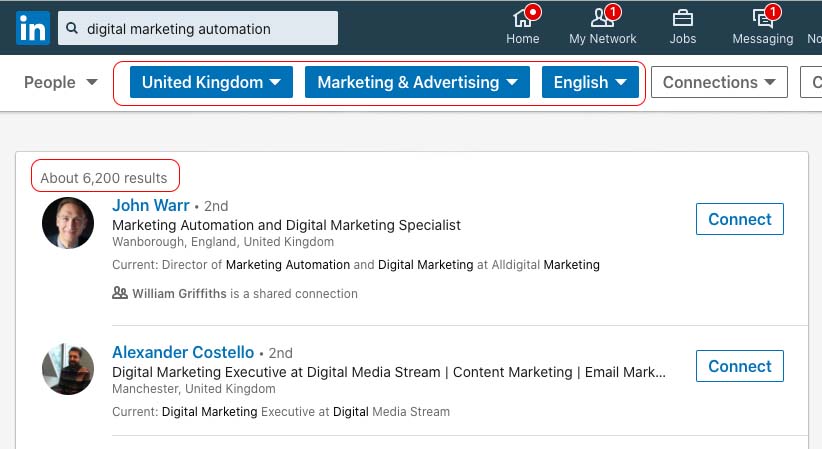
Now the real work begins. You have two options for sifting through these results: the free option, which is time consuming, but… well, free. Or, you can utilise LIX’s ability to export ‘deep’ LinkedIn profile data (there is a short ‘how-to’ for this feature within our video CV parsing on YouTube!).
Using LIX Deep Profile Extraction will allow you export up to 1k profiles per day, directly in to XLS or CSV. The tool will extract the number of followers a person has directly to your spreadsheet, making it easy to identify influencers within this niche. You can simply sort your results by ‘followers’ within Excel or Numbers and work your way along the top results to discover those who post relevant, engaging content. Voila! You have your list of targets. If your CRM supports CSV or XLS uploads, it’s a good idea to move these potential influencers over for better tracking and organisation.
If you’re opting for the manual method, the end result is the same but you will need to sort through those profiles one by one to find their follower numbers, select the best candidates and copy their details into the list-maker, spreadsheet or CRM of your choice.
When manually sifting through, head to the user’s profile and click on ‘activity’. Here you will find the number of followers, along with a list of their posted content (articles, feed posts etc.). With this information, we can make informed decisions about potential influencers.
Our example search led us to this handsome fellow, with following within our desired range and well-engaged posts. Maybe he’s right for our LinkedIn influencer marketing campaign?:
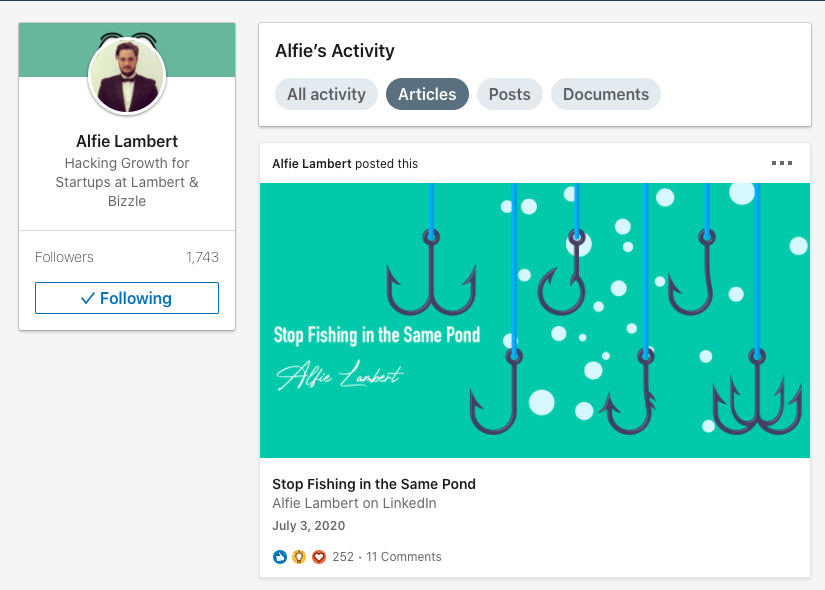
Groups
Another place to search is within the ever-popular LinkedIn groups. There are over 2 million groups on LinkedIn. According to Tech Crunch, more than half of all LinkedIn users are in at least one group.
Within these groups, you tend to find that there are usually a handful of regular posters. They tend receive a good response, with strong engagement on their posts. These are your influencers. If we return to our example search, we can see that there are 289 groups that match our keywords. The largest groups should command the most engagement, therefore leading you to your potential influencers faster. My advice is to not neglect the smaller groups however – sometimes you can unearth a gem.
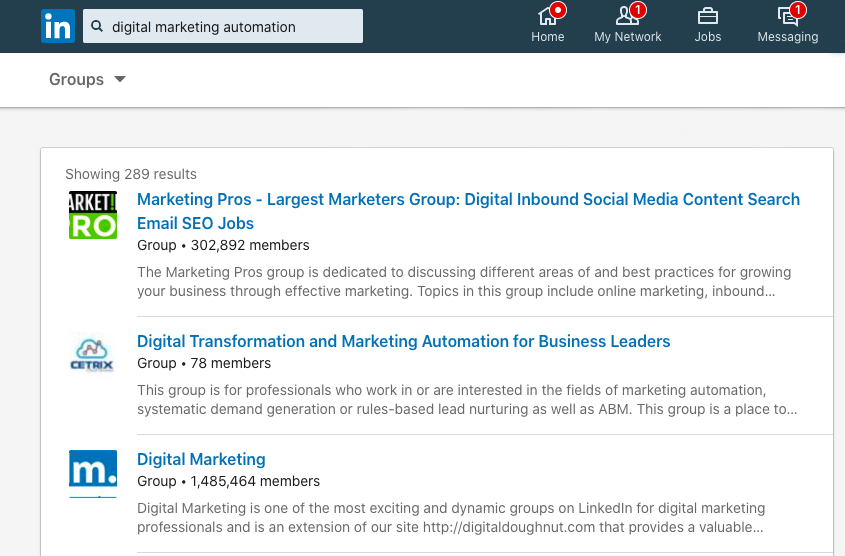
How to Approach LinkedIn Influencers
We have targets in our crosshairs, now it’s time to get them on board. This is not as straightforward as it may seem on the surface. Just because we want to work with them, does not mean that they instantly want to work with us. Remember, these influencers have spent years cultivating an audience and presenting themselves as thought leaders within their field. They will not risk sullying their reputation and standing in the community if they feel that your brand isn’t the right fit, or the product isn’t right for their audience. In order to leverage the trust that influencers have built up with their followers, you need to build trust with the influencer.
Email vs. LinkedIn Messages?
This may seem like an easy choice. We’re already using LinkedIn, so why not just message them there? In reality, it depends on how quickly you’re looking to receive a response.
If you’re a regular LinkedIn user you will no doubt receive dozens of messages every week. Many of which are ‘spammy’ or annoying. Usually they are connected to a connection request (the only way to message a user not within your connections, unless you have a paid version of LinkedIn such as Sales Navigator).
This, I think, is the reason why people put off regularly reading their LinkedIn messages. Personally, I check my emails 10+ times a day and my LinkedIn messages perhaps 2-3 times a week.
Want your message to cut through the noise of LinkedIn and receive a faster response? Find your influencer’s email address and contact them there. If in the last step you used LIX to export data from LinkedIn, you will notice that where a person has listed their email address on their profile, their email address will have been exported onto your spreadsheet. If you’re working manually, head to Google and do your best to find it that way. Happy sleuthing.

For those of you not in a hurry to receive a response, or struggling to find those emails, LinkedIn messaging is fine. My advice here is to start strong. You’ll notice in your inbox; you get a short preview of around 10 words before opening a message. Make those 10 words count.
Opening with a standard “Hi, I hope you are well” is not going to stand out in a crowded inbox. This is the exactly the kind of message I put off until I cannot stand the notifications any longer. Mainly because I have no idea what is inside. It could be anything from a cold sales pitch, a job offer, or just straight up spam.
What do you think will capture the attention of your chosen influencer?
Here are a few 10-word examples that I’ve used in the past with some success.
Paid promotion opportunity: We would like to work with you…
We’ve identified you as a LinkedIn influencer in ‘X’ field…
Excellent content, we would like to discuss a sponsored post…
These may seem a little impersonal, and they are. These openers on LinkedIn are not designed to build rapport (yet, that comes later). These are designed to grab attention in a stuffed inbox, enticing the influencer to read your message.
You can also use variations of these openers as email subject headers if you choose to contact your influencers that way!
Messaging
For some of us, contacting and building rapport with people comes naturally – for others, not so much. If you’re the kind of person who listens in to the sales team making calls and thinks “how do they do that??”, this section is for you.
You’ve already grabbed their attention and got them to open the message. All we need to establish now is who you are, what you do and whether they would be interested in learning more about this opportunity. That’s it. At this stage, don’t bog them down with a ton of details, don’t discuss fees or even what the promotion is. Those details can come after you receive your first ‘yes’. Up until the point at which they agree to talk further (your first ‘yes’) you are talking at them, not with them. We need to open up a conversation in which both parties are happy to participate.
Continuing our example, here’s a sample message I would send to our digital marketing & automation influencer:
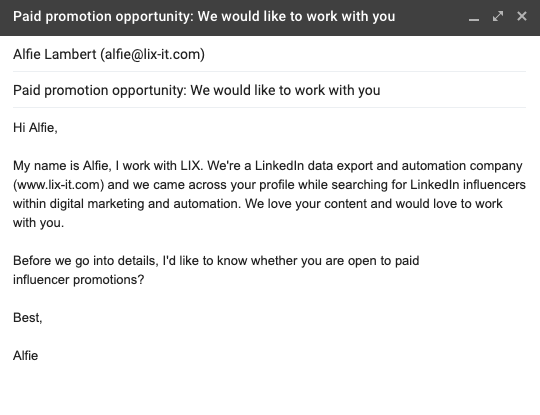
It’s straightforward and to the point, without being pushy or presumptuous. Another technique that can work well here is referencing what you think makes them the perfect candidate. If they wrote a great blog about your niche, or received a ton of engagement for a post, reference it!
“I saw your blog about automation and thought it was excellent. I especially like your take on setting responsible limits….”
Influencers may put out content in order to win business, but they also like getting good feedback too! Even the least-vain influencers respond well to a little praise.
Some people like to use what is called ‘presumptive closing’. This when you push the person receiving your correspondence into agreeing to a proposition. Something like:
“We want to work with you. I’m calling influencers on Friday, what’s the best time for us to speak – 11am or 1pm?”
I tend to find, however, that influencers receive a lot of messages from a lot of salespeople and are pretty fed up with the pushy approach!
When you have their reply, hopefully saying that yes, they’re happy to discuss; you’re ready to go into details with them.
Now that you have read, absorbed and percolated this information it’s time to go forth and put it into action! LinkedIn is an untapped treasure trove of B2B influencers – get out there and tap it.
Find more blogs from LIX, here.
